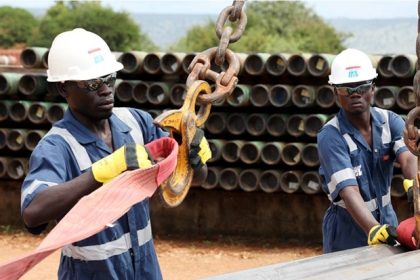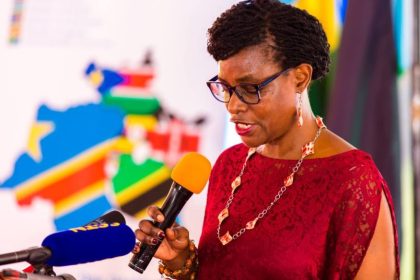WFP 2015 assistance reaches one million in Uganda
KAMPALA January 08– The United Nations World Food Programme (WFP) assisted close to a million people in Uganda during 2015, nearly 200,000 more than in 2014- the product of regional crises and expanded WFP programmes to tackle post-harvest losses and malnutrition.
“The number of South Sudanese refugees in Uganda has increased nearly eight-fold since fighting broke out in their country in December 2013, and more people continue to arrive in Uganda daily from Burundi, DR Congo and other countries,” Acting WFP Country Director Michael Dunford said. “There are now over half a million refugees in the country, most of whom rely heavily on WFP food assistance and nutrition supplements for young children.
Dunford said the WFP was grateful to Canada, the European Commission, France, Ireland, the United Kingdom and the United States, as well as multilateral and private donors, for their contributions, which enabled the agency to reach nearly a million people.
“WFP is now feeding 360,000 refugees in Uganda, which is the highest number of refugees we have ever supported here,” Dunford said.
Other areas of WFP’s work also grew in 2015. Compared to 2014, WFP more than doubled the number of small-scale farmers it assisted with skills and technologies to reduce post-harvest food losses. The organization reached 38,000 farmers in a programme that strongly incorporates the private sector for self-sustainability. Farmers who had previously lost up to 40 percent of their crops after harvest reported cutting those losses to less than 2 percent after enrolment in the project.
To help reduce rates of anaemia, which affects nearly half of all young children in Uganda, WFP, in collaboration with the Ministry of Health, introduced a programme providing mothers with micronutrient powders – each sachet containing 15 vitamins and minerals – to add to their children’s food at home.
WFP also introduced a new preventive approach to its nutrition support for South Sudanese refugees. Known as “blanket supplementary feeding,” this initiative provides specialized nutritious foods for new arrivals of South Sudanese refugee children aged from 6-23 months, to protect them from undernutrition.
Working closely with the Office of the Prime Minister and the United Nation’s High Commissioner for Refugees (UNHCR), WFP began a livelihoods programme among longer-term refugees and Ugandans in the host communities, in line with the government’s Settlement Transformation Agenda (STA). The STA is intended to address the quality of refugees’ livelihoods in order to build their resilience.
WFP expanded its cash assistance programme for refugees in 2015 to a new high of 35,000 people, and plans to further expand this type of assistance in 2016. In settlements where markets are functional, WFP offers longer-term refugees a choice between food and cash. This gives families more choice in how they meet their food needs, and allows them to buy fresh foods and diversify their diets.
In Karamoja, WFP implemented six programmes aimed at building resilience among households and communities. The programmes included support for more than 143,000 extremely food insecure people, plus targeted nutrition support for 80,000 malnourished young children, pregnant women and breastfeeding mothers during a prolonged lean season. The Karamoja initiatives also included support for nearly 200,000 moderately food insecure people participating in food-for-assets projects in which they built or improved community infrastructure. WFP provided daily school meals to all children attending school throughout Karamoja.
WFP provided logistics and technical support to the government’s “Karamoja feeds Karamoja” programme, through which the government gave cereals for WFP’s food basket for all 284 schools in the region. This collaboration is part of WFP’s efforts to support local solutions for school meals and an eventual hand-over of the programme to the government.
Support from donors enabled WFP to contribute to Uganda’s local economy through local food purchases and the transportation sector. In 2015, WFP bought 55,600 metric tons of food in Uganda worth US$20 million; small-scale farmers supplied 14 percent of that food. WFP spent another US$10 million hiring local transport companies to move food inside Uganda and to neighbouring countries.
“WFP activities support the Second National Development Plan, Vision 2040 and the Sustainable Development Goals,” Dunford said.
In 2015, the following donors contributed to WFP in Uganda (in alphabetical order): Canada (US$1.6 million), the European Commission’s Humanitarian Aid and Civil Protection Department (ECHO) (US$1.6 million), France (US$221,000), Ireland (US$1 million), the Lift a Life Foundation (US$450,000), the Louis Dreyfus Foundation (US$576,000), multilateral donors (US$10.8 million), United Kingdom (US$11.3 million), the UN Central Emergency Response Fund (US$771,000), the UPS Foundation (US$176,000) and the United States (US$27 million).

 AfDB puts up nearly $700m for Burundi-Tanzania SGR link
AfDB puts up nearly $700m for Burundi-Tanzania SGR link
 Bank of Uganda keeps base rate at 9.5% to support surge in GDP growth
Bank of Uganda keeps base rate at 9.5% to support surge in GDP growth
 Africans must resist being bulldozed in energy transition timetable debate
Africans must resist being bulldozed in energy transition timetable debate
 Standard Bank Group appoints new Chief Executive for Uganda Holdings
Standard Bank Group appoints new Chief Executive for Uganda Holdings
 TradeMark Africa introduces new App to limit EAC trade barriers
TradeMark Africa introduces new App to limit EAC trade barriers
 Employer hiring up during November as Stanbic PMI rises to 53.4
Employer hiring up during November as Stanbic PMI rises to 53.4
